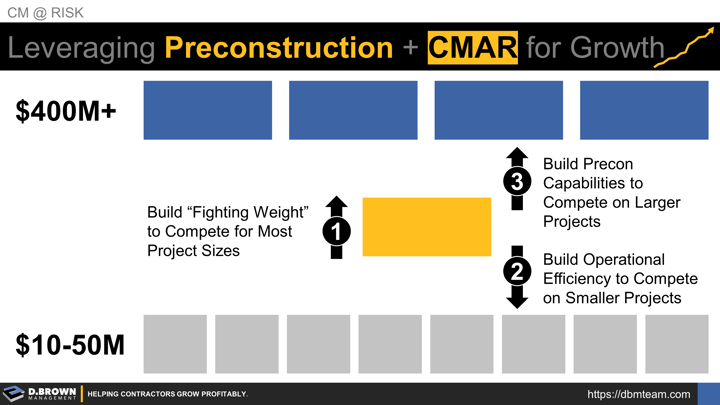Leverage 360 degrees of perspective as Raymond Braswell and David Brown discuss all elements of building a competitive advantage through Preconstruction Services. Raymond brings the unique perspective to the situation, having served in the role of Architect, General Contractor, Developer and Owner’s Representative during the last 30 years.
Dominate your competition by contracting for preconstruction services while projects are still concepts on scratch paper. This series of videos will look at the preconstruction process from the perspective of the Project Owner, Architect, and Contractor. Topics covered include Napkins-to-Nails estimating methodologies, communication strategies, change management, team structure, contracting methods, pricing and selling preconstruction services.
Leveraging Preconstruction Services and CM @ Risk to Build a Competitive Advantage
Many contractors in many markets can use this three-phase strategy to achieve sustainable growth by leveraging CM at Risk (https://dbmgt.co/2Fs8j55) and advanced preconstruction services (https://dbmgt.co/2FDgv2e) to build a competitive advantage.
Every market contains a mix of smaller contractors who are extremely competitive going after smaller projects with a few larger players including some from out of the area who build the larger projects. These larger projects have less competition and are often negotiated with the contractor selected based on qualifications.
If you are at the smaller end of the scale, you must execute a three-phase strategy for growth. Execute well and you will find that within years you will be regularly competing with and winning against the bigger players.
- Build to “Fighting Weight” where you have the project team resources to reasonably compete for larger projects. You simply need to be able to compete in the heavyweight range. Not win every time but at least go through a few rounds and be good competition.
- Build and maintain operational efficiency so that you can continue to compete on the smaller projects. You can’t lose this ability as you build to your fighting weight.
- Build very strong preconstruction services to give you a competitive advantage. By getting creative at the precon phase a “David” can easily beat a “Goliath” - don’t assume you are at a disadvantage.
Bonus - getting in at the precon phase gives you time to recruit rather than the shorter fuse of a Design-Bid-Build project.
This is Part 1 of a 12 Part Series
Topics Covered in the Series Include:
- Assessing your current preconstruction processes
- Developing a preconstruction workflow specific to your market
- Building the right preconstruction team for your company
- Effectively communicating with the Architect and Owner
- Conceptual estimating strategies, tactics, and tools
- Presenting the value of your preconstruction services
- Contracting methods for preconstruction services

